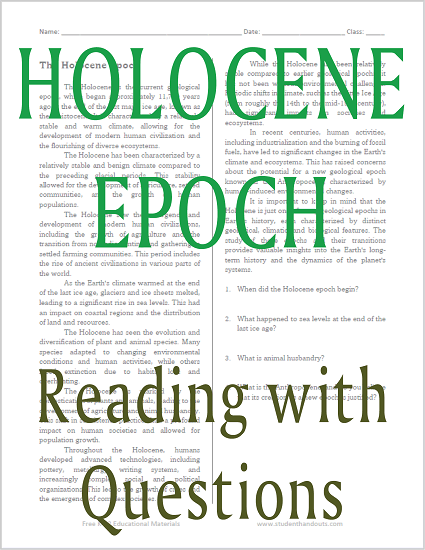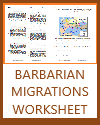| Holocene Epoch Reading with Questions |
|---|
| www.studenthandouts.com ↣ World History ↣ Early Humans ↣ Early Humans Worksheets |
 |
    |
|
Click here to print. Answer key: (1) approximately 11,700 years ago; (2) significant rise in sea levels; (3) domestication of animals; (4) answers will vary but should contain that it is characterized by human-induced environmental changes. The Holocene is the current geological epoch, which began approximately 11,700 years ago at the end of the last major ice age, known as the Pleistocene. It is characterized by a relatively stable and warm climate, allowing for the development of modern human civilization and the flourishing of diverse ecosystems. The Holocene has been characterized by a relatively stable and benign climate compared to the preceding glacial periods. This stability allowed for the development of agriculture, settled communities, and the growth of human populations. The Holocene saw the emergence and development of modern human civilizations, including the growth of agriculture and the transition from nomadic hunting and gathering to settled farming communities. This period includes the rise of ancient civilizations in various parts of the world. As the Earth's climate warmed at the end of the last ice age, glaciers and ice sheets melted, leading to a significant rise in sea levels. This had an impact on coastal regions and the distribution of land and resources. The Holocene has seen the evolution and diversification of plant and animal species. Many species adapted to changing environmental conditions and human activities, while others faced extinction due to habitat loss and overhunting. The Holocene is marked by the domestication of plants and animals, leading to the development of agriculture and animal husbandry. This shift in subsistence practices had a profound impact on human societies and allowed for population growth. Throughout the Holocene, humans developed advanced technologies, including pottery, metallurgy, writing systems, and increasingly complex social and political organizations. This led to the growth of cities and the emergence of complex societies. While the Holocene has been relatively stable compared to earlier geological epochs, it has not been without environmental challenges. Periodic shifts in climate, such as the Little Ice Age (from roughly the 14th to the mid-19th century), had significant impacts on societies and ecosystems. In recent centuries, human activities, including industrialization and the burning of fossil fuels, have led to significant changes in the Earth's climate and ecosystems. This has raised concerns about the potential for a new geological epoch known as the Anthropocene, characterized by human-induced environmental changes. It is important to keep in mind that the Holocene is just one of many geological epochs in Earth's history, each characterized by distinct geological, climatic, and biological features. The study of these epochs and their transitions provides valuable insights into the Earth's long-term history and the dynamics of the planet's systems. |
| Early Humans Books and Films | Early Humans Outlines and PowerPoints |
| Early Humans Maps and Pictures | Early Humans Study Games |
| Early Humans Miscellany | Early Humans Worksheets |
| www.studenthandouts.com ↣ World History ↣ Early Humans ↣ Early Humans Worksheets |








